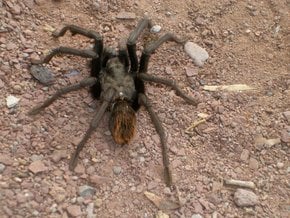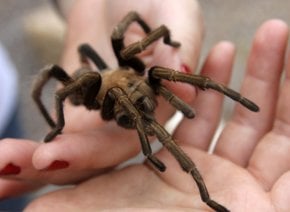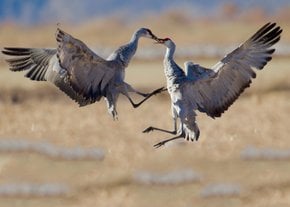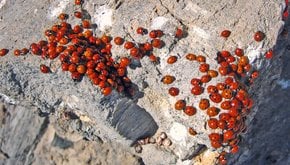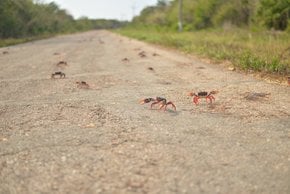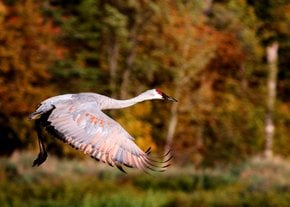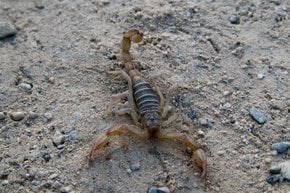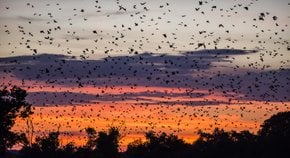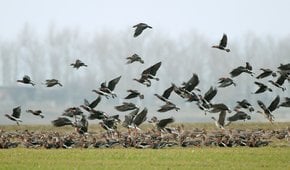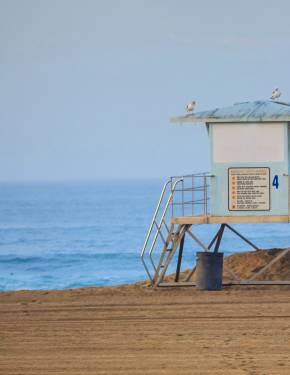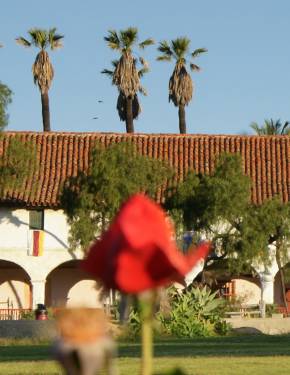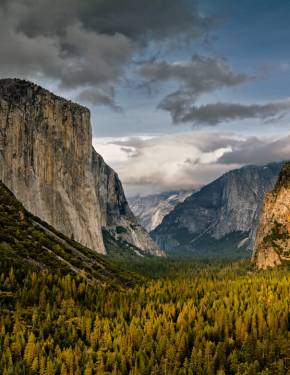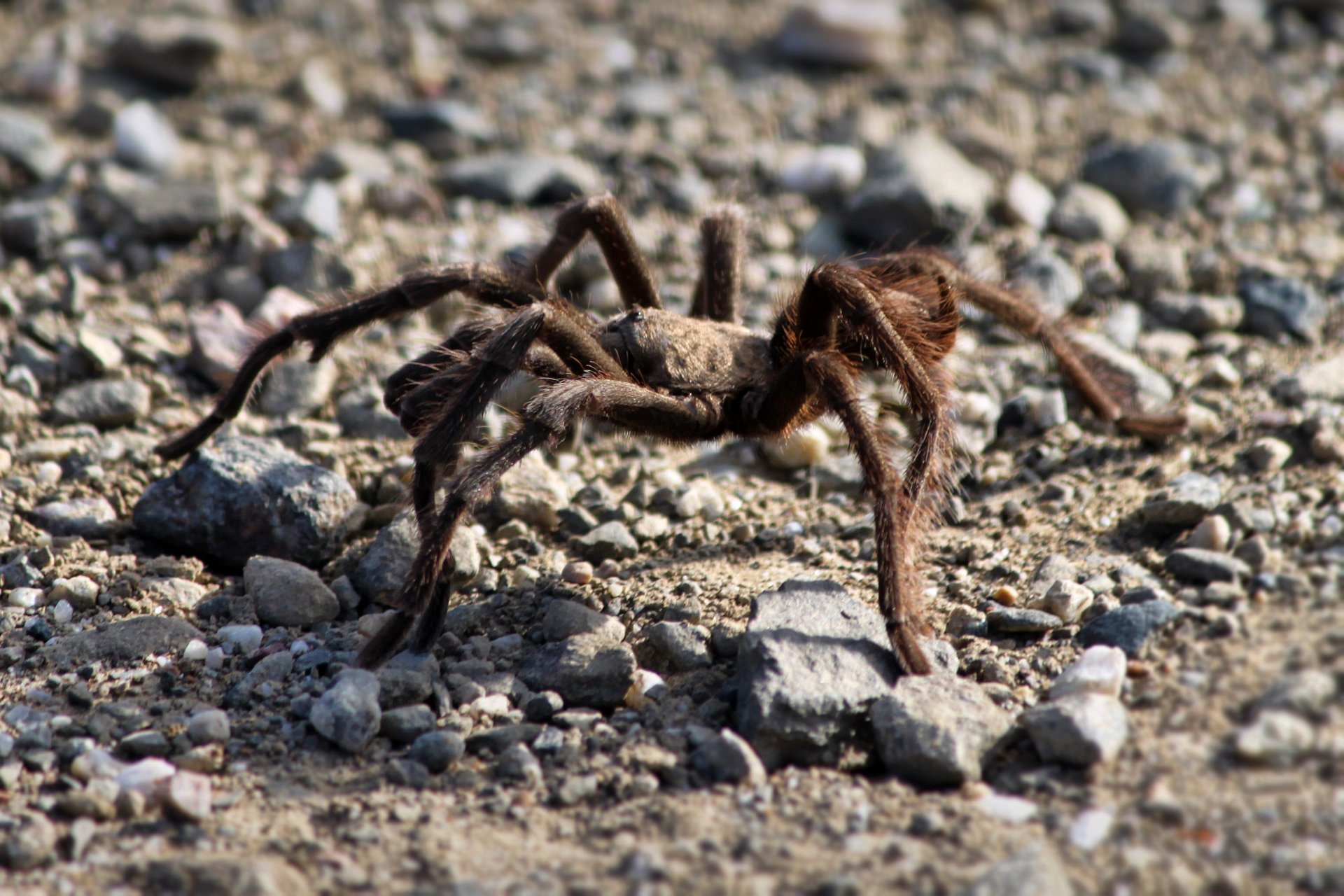

Every fall, North American tarantulas migrate in search of a mate, traveling distances from a few inches up to a mile. During September and October, you can observe these large, hairy spiders, known as brown tarantulas or Aphonopelma hentzi, on trails, roads, and grasslands from the Bay Area, including Mount Diablo State Park, to Southern California.
Mating Season
During this season, the spiders you might see crawling around are almost entirely male tarantulas searching for a female burrow, which looks like a hole dug in the ground with the spider's fangs. Females lay down pheromones, or chemical signals, to indicate to the males that they are of the same species. As the male approaches the female's burrow, he'll smell the silk to ensure he's on the right track. He then communicates with the female by tapping on the silk, which she can detect with the "ears" on her feet. Once mated, the female tarantula lays fertilized eggs that remain in her burrow. The young hatch and emerge in the spring, soon leaving to dig their own burrows nearby.
What is the best time to See Migrating Tarantulas?
Historically, the mating season has fallen between late September and early October. Still, now, tarantula mating season in California usually begins in late August and lasts through early November, with peak activity around mid-October, when tarantulas take advantage of cooler temperatures.
Where to See Tarantula Migration in California?
Bay Area
Some of the best places to spot tarantulas around the Bay Area are in the region's grassy oak woodlands, where they are more prevalent than in redwoods or densely forested areas. Prime locations include Del Valle, Sunol Regional Wilderness, Mount Diablo, Mount Hamilton, Henry W. Coe State Park, Black Diamond Mines in Antioch, Ed R. Levin Park, and the Stanford Dish Loop trail.
Los Angeles
Arachnids are often spotted in Griffith Park, Los Angeles, around Malibu Creek State Park, Topanga State Park in the Santa Monica range, and Eaton Canyon in the San Gabriel Mountains.
San Diego
Spiders love desert climates so that you can find plenty near San Diego. Check Anza-Borrego Desert State Park, Santa Ysabel Preserve, the Mojave Desert, and Joshua Tree National Park.
Tarantula Hikes
Various regional parks offer annual tarantula hiking tours in September–October to see the spiders in the wild. The East Bay Regional Park District hosts free tarantula treks in both Del Valle Regional Park and Sunol Regional Wilderness. Save Mount Diablo and the Mount Diablo Interpretive Association facilitate hikes at Mount Diablo State Park on September 15 for a $6 park entrance fee.
Safety Tips
Tarantulas, though harmless to humans, typically avoid encounters and will flee if approached. It's wise to maintain a respectful distance unless guided by a naturalist, as they may bite if they feel threatened. When driving near tarantula habitats, exercise caution, as they can sometimes be seen crossing roads, appearing as small black or brown specks. Sightings are more common around dusk, with cooler afternoons offering the best chances of spotting these fascinating creatures in our local parks.
Tarantula's Lifespan
Tarantulas live most of their lives in burrows. Males stay there for seven to eight years until they reach adulthood. Then they leave their hideaways for just a few weeks to find a mate and unfortunately die shortly afterward. The female tarantula either eats them, or they die within weeks or months afterward. Females usually enjoy a longer life, staying in their burrows for about 2o years.
Practical info
What are tarantulas?
Tarantulas are arachnids of significant size with hair covering their body found in several regions of California. They make an appearance outside the burrows as males search for mates, typically between September and October. Surprisingly, tarantulas are quite harmless to humans and often shy away from them, making them fascinating creatures to witness! Show more
When is the best time to observe tarantulas in California?
To observe the tarantula migration, visiting between September and October would be ideal when males emerge from their burrows on a quest for a mate. This natural phenomenon can make the trip worth taking as witnessing large tarantulas moving outside their burrow can give an adrenaline rush! Not only that, but this season leads to an increase in tarantula sightings, both for tourists and locals, in California. Show more
Where can I observe tarantulas in California?
Tarantulas can be observed in multiple parks and deserts in California. Some of the popular locations include Griffith Park, Los Angeles, Mount Diablo State Park, Eaton Canyon, Malibu Creek State Park, and Topanga State Park, among others where tarantulas migrate and are safe to observe. Moreover, in places like Santa Ysabel Preserve and Anza-Borrego Desert State Park, tarantula sightings occur more frequently. Show more
How long do tarantulas stay in burrows?
Male tarantulas hide in their burrows for about 7-8 years until their adulthood. Females, on the other hand, like to spend more time in their habitats, usually 20 years in their burrows. Male tarantulas live a short life compared to females and leave their hideaways for a brief period during the breeding season, after which they usually die due to exhaustion or any other cause. In contrast, females can mate more than once in their lifespan and live longer. Show more
Why do male tarantulas leave their burrows?
In search of a suitable mate, male tarantulas leave their burrows and move from place to place, traveling either inches or miles. Their movements outside the burrows increase and become more frequent during the breeding season, making them more active and visible to nature enthusiasts. Lamentably, the male tarantula dies soon after mating. On the other hand, female tarantulas wait in their burrows for the males to approach them. Show more
External Resources
Find hotels and airbnbs near Tarantula Migration (Map)
- Mount Diablo State Park
- Mount Hamilton
- Henry W. Coe State Park
- Del Valle Regional Park
- Sunol Regional Wilderness
- Black Diamond Mines
- Ed R. Levin Park
- Stanford Dish Hiking Trail
- Griffith Park
- Malibu Creek State Park
- Topanga State Park
- Eaton Canyon
- Anza Borrego State Park Desert
- Joshua Tree National Park
- Santa Ysabel Park
- Mojave Desert
- Red Rock Canyon State Park



